Invited Talks
MaP regularly invites outstanding scientists to give a lecture at ETH Zurich.
Currently no planned lectures. Please come back later.
Previous Invited Lectures
MaP MERCK Lecture
Prof. Jos Malda, University Medical Center Utrecht and University Utrecht
Biofabrication Technologies for Osteochondral Regeneration
15 February 2024, 10.30-12.00 | ETH Zentrum HG D 1.1
On 24 October 2023, Prof. Robert S. Langer from external page Massachusetts Institute of Technology MIT held an online talk on:
Controlling the release of large molecules from biomaterials: How overcoming skepticism led to new medical treatments and ways to tackle a global health challenge
Advanced drug delivery systems are having an enormous impact on human health. We start by discussing our early research on developing the first controlled release systems for macromolecules and the isolation of angiogenesis inhibitors and how these led to numerous new therapies. This early research then led to new drug delivery technologies including nanoparticles and nanotechnology that are now being studied for use treating cancer, other illnesses, and in vaccine delivery (including the Covid-19 vaccine). We are also developing drug delivery microchips and robotic pills. Finally, by combining mammalian cells, including stem cells, with synthetic polymers, new approaches for engineering tissues are being developed that may someday help in various diseases. These can also serve as a basis for tissues on a chip which can potentially reduce animal and human testing. Examples in the areas of cartilage, skin, blood vessels, GI tract and heart tissue are discussed.
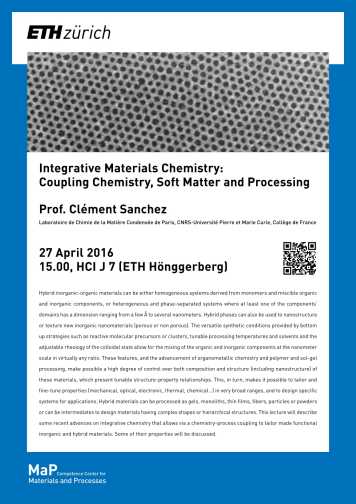
On 27 April 2016 we had a MaP talk given by external page Prof. Clément Sanchez from Collège de France on:
Integrative Materials Chemistry: Coupling Chemistry, Soft Matter and Processing
Hybrid inorganic-organic materials can be either homogeneous systems derived from monomers and miscible organic and inorganic components, or heterogeneous and phase-separated systems where at least one of the components’ domains has a dimension ranging from a few Å to several nanometers. Hybrid phases can also be used to nanostructure or texture new inorganic nanomaterials (porous or non porous). The versatile synthetic conditions provided by bottom up strategies such as reactive molecular precursors or clusters, tunable processing temperatures and solvents and the adjustable rheology of the colloidal state allow for the mixing of the organic and inorganic components at the nanometer scale in virtually any ratio. These features, and the advancement of organometallic chemistry and polymer and sol-gel processing, make possible a high degree of control over both composition and structure (including nanostructure) of these materials, which present tunable structure-property relationships. This, in turn, makes it possible to tailor and fine-tune properties (mechanical, optical, electronic, thermal, chemical…) in very broad ranges, and to design specific systems for applications. Hybrid materials can be processed as gels, monoliths, thin films, fibers, particles or powders or can be intermediates to design materials having complex shapes or hierarchical structures. This lecture will describe some recent advances on integrative chemistry that allows via a chemistry-process coupling to tailor made functional inorganic and hybrid materials. Some of their properties will be discussed.
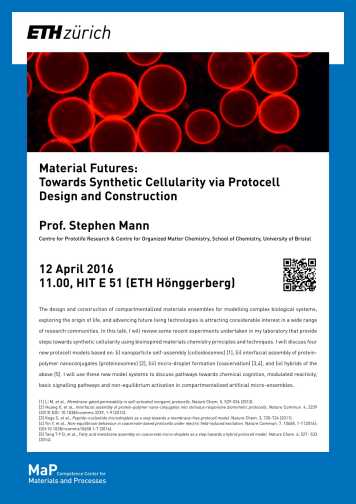
On 12 April 2016 external page Prof. Stephen Mann from the University of Bristol gave a MaP Talk on:
Material Futures: Towards Synthetic Cellularity via Protocell Design & Construction
The design and construction of compartmentalized materials ensembles for modelling complex biological systems, exploring the origin of life, and advancing future living technologies is attracting considerable interest in a wide range of research communities. In this talk, I will review some recent experiments undertaken in my laboratory that provide steps towards synthetic cellularity using bioinspired materials chemistry principles and techniques. I will discuss four new protocell models based on: (i) nanoparticle self-assembly (colloidosomes), (ii) interfacial assembly of protein-polymer nanoconjugates (proteinosomes), (iii) micro-droplet formation (coacervation), and (iv) hybrids of the above. I will use these new model systems to discuss pathways towards chemical cognition, modulated reactivity, basic signaling pathways and non-equilibrium activation in compartmentalized artificial micro-ensembles.
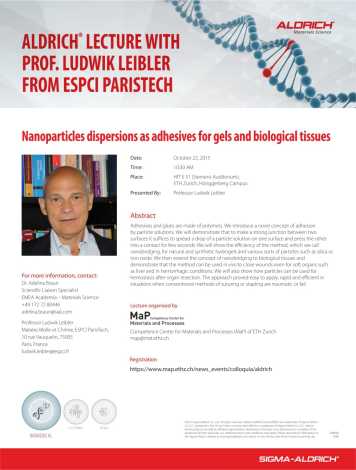
On 22 October 2015 we had our First Aldrich Lecture given by external page Prof. Ludwik Leibler from ESPCI ParisTech on:
Nanoparticles dispersions as adhesives for gels and biological tissues
Adhesives and glues are made of polymers. We introduce a novel concept of adhesion by particle solutions. We will demonstrate that to make a strong junction between two surfaces it suffices to spread a drop of a particle solution on one surface and press the other into a contact for few seconds. We will show the efficiency of the method, which we call nanobridging, for natural and synthetic hydrogels and various sorts of particles such as silica or iron oxide. We then extend the concept of nanobridging to biological tissues and demonstrate that the method can be used in vivo to close wounds even for soft organs such as liver and in hemorrhagic conditions. We will also show how particles can be used for hemostasis after organ resection. The approach proved easy to apply, rapid and efficient in situations when conventional methods of suturing or stapling are traumatic or fail.
Many thanks to our sponsor external page Sigma Aldrich!
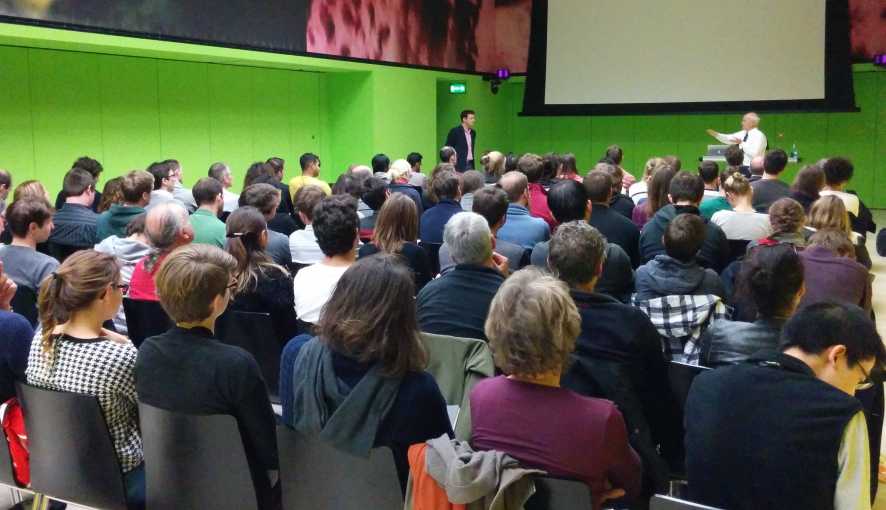
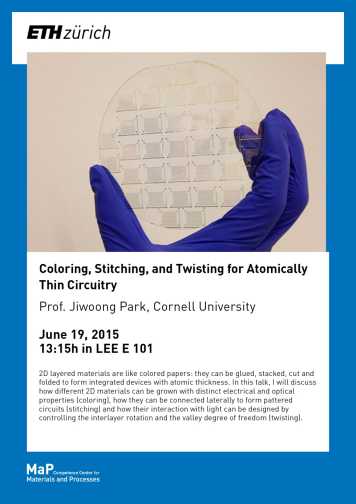
On 19 June 2015 we had a MaP talk given by external page Prof. Jiwoong Park from Cornell University on:
Coloring, Stitching, and Twisting for Atomically Thin Circuitry
2D layered materials are like colored papers: they can be glued, stacked, cut and folded to form integrated devices with atomic thickness. In this talk, I will discuss how different 2D materials can be grown with distinct electrical and optical properties (coloring), how they can be connected laterally to form pattered circuits (stitching) and how their interaction with light can be designed by controlling the interlayer rotation and the valley degree of freedom (twisting).